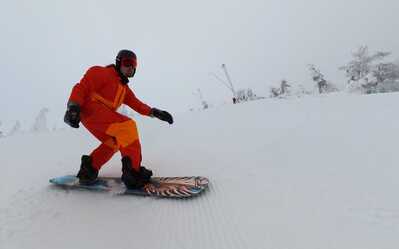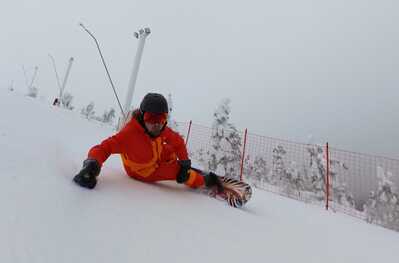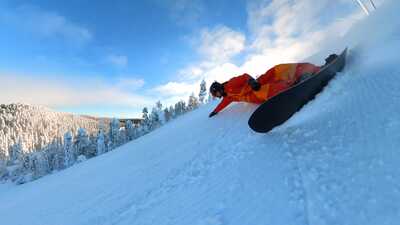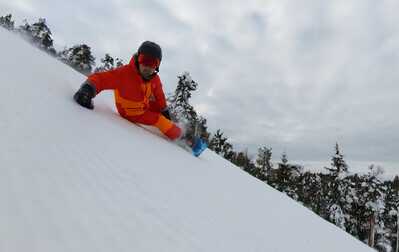Carving Switch
Does anyone here carve both forward and switch, Ryan Knapton style?
I'm not a great carver (yet), but I'm starting to get pretty comfortable with riding switch, and I love the idea of going in and out of tricks without regard to board direction. So I wonder, is it harder to carve with your feet in duck stance? Anyone tried both duck and forward stances and preferred one or the other? What are the drawbacks of duck? Am I going to kill my knees?
I've been working a lot with this topic and I've managed to adapt the EC (Extreme carving) technique to duck stance pretty well. I'm now learning to ride switch better and that's still a work in progress. In any case I don't see why switch wouldn't work just as well because I'm using symmetric stance. My current board is directional though but I've tried the same technique with Knapton Twin as well and it works fine. Here's a short vid where I demonstrate the hip rotation for heelside turns:
... and here's a vid about how the riding looked couple of months ago in early season man made snow conditions:
I have quite a bit of new unedited footage and I'm planning to do a brief tutorial about this style. The idea is that it will be based on posi-posi curriculum since the hip rotation is super important part of the technique and James (and Lars from Justaride for example) already teach that really well so I have no reason to repeat those topics.
So I wonder, is it harder to carve with your feet in duck stance? ... What are the drawbacks of duck? Am I going to kill my knees?Posted by: @fooltoque
Heelsides are significantly harder and toesides are marginally easier. You need a lot of hip rotation for the heelside and duck stance makes that much more difficult than posi-posi. My suggestion is to learn the hip rotation with posi-posi first and then try if you can open your hips enough to carve duck with that technique. That's what I did. I don't have any problems with my knees when carving deep with a -21R/+21F duck stance.
not an expert but according to your videos e.g. at 0.28 you make a more "upper body" rotation instead of hip rotation.
But I dont think that a bigger hip rotaition with duckstance is more possible as you already do.
Only a snowboarder knows this feeling. And once you've felt it for yourself, it's impossible not to want more. It's so addictive that it should be illegal, but it's not and that's why they make such good snowboards that after riding them you want to sell everything and move to the mountains, because a man has to have a balance in his life, and that balance should be 80% snowboarding and 20% working.
Posted by: @turmsnot an expert but according to your videos e.g. at 0.28 you make a more "upper body" rotation instead of hip rotation.
But I dont think that a bigger hip rotaition with duckstance is more possible as you already do.
The way I see it is that the upper body rotation by itself doesn't solve the heelside turn but it does aid in turning when combined with the hip rotation. The thing with hip rotation is that it's relative to the basic position. For posi-posi riding, the basic position is already pointing a bit (or a lot, depending on the angles) towards the nose so after doing the hip shift, the hips should be facing even more towards the nose or even past the nose in extreme cases. With duck stance on the other hand, the basic position points towards the toeside edge (with symmetric duck) so if you add the same amount of hip rotation, you won't be rotated as much (in relation to the board) as with posi-posi stance. This is also a big reason why duck heelsides are bound to be less powerful than posi-posi heelsides either way.
I'm not sure to which video you refer to but if you mean that "black diamond" vid at 28sec., you are very much correct that there isn't much hip rotation going on and that's also the reason why that particular turn is a failure in my opinion. There's quite a bit of chatter in that turn, not my finest work. It would have been a lot better with more and earlier hip rotation. Also that vid is the first time I managed to do that kind of turns I was happy enough with. Now I've had time to polish them. Here's a screenshot from yesterday where the hip rotation is already good during the transition. This allows me to get to the laid down position earlier and this is what I try to demonstrate in the hip shift vid:
https://photos.app.goo.gl/rWuss4PCL9PcUmvb9
... and the from the same turn a bit later I have switched to the part where I pressure the nose:
https://photos.app.goo.gl/eWn5n6ZKuP9FnNrh6
I'll try to make a video about this later so these are just teasers but I'm happy to discuss the topic this way as well. In any case the 28sec. turn of that "black diamond" vid is a good example of a weak turn caused by lack of hip rotation even if it has decent upper body rotation. Same problem will happen with posi-posi stance as well if you don't rotate the hips past the basic position.
All this said, these are just tools and it's up to the rider to decide what feels best for whatever situation. Not every turn has to have the most rotation possible. The screenshots in this post are my best effort examples where I try to exaggerate the hip shift to show what I mean. More aggressive hip shift results in a tighter turn and sometimes you might not want to turn that tight. Upper body rotation is important as well but in my opinion aggressive upper body rotation doesn't fix the lack of hip rotation.
Finally here's a screenshot from a turn where I'm happy with the rotation. I could still try to get my body even closer to the snow but that's just fine tuning:
https://photos.app.goo.gl/zJqeFANaCykQoh2W9
All of these examples are from the same slope and all are recorded with a selfie stick which also screws up the riding a bit.
Those are some sick turns!
Posted by: @xargoI have quite a bit of new unedited footage and I'm planning to do a brief tutorial about this style. The idea is that it will be based on posi-posi curriculum since the hip rotation is super important part of the technique and James (and Lars from Justaride for example) already teach that really well so I have no reason to repeat those topics.
I look forward to that. Subscribed 👍
Posted by: @xargoHeelsides are significantly harder and toesides are marginally easier. You need a lot of hip rotation for the heelside and duck stance makes that much more difficult than posi-posi. My suggestion is to learn the hip rotation with posi-posi first and then try if you can open your hips enough to carve duck with that technique. That's what I did. I don't have any problems with my knees when carving deep with a -21R/+21F duck stance.
Angles were part of my motivation for this post. Last weekend I had a lot of trouble with pain in my lower leg at +15,-15. I quick google search showed a lot of people saying to not go past a 30 degree angle between the feet, but it was all just anecdotal sources, so I had planned to try +18,-18. Maybe I should try farther.
Regarding trying with posi-posi to get the feel of the hip rotation, I think I'll try it. Nothing to lose after all. Maybe +30,+15?
@xargo yes indeed. In this photos the hip rotation is more obvious. Nice....
Only a snowboarder knows this feeling. And once you've felt it for yourself, it's impossible not to want more. It's so addictive that it should be illegal, but it's not and that's why they make such good snowboards that after riding them you want to sell everything and move to the mountains, because a man has to have a balance in his life, and that balance should be 80% snowboarding and 20% working.
Posted by: @xargoPosted by: @turmsnot an expert but according to your videos e.g. at 0.28 you make a more "upper body" rotation instead of hip rotation.
But I dont think that a bigger hip rotaition with duckstance is more possible as you already do.
The way I see it is that the upper body rotation by itself doesn't solve the heelside turn but it does aid in turning when combined with the hip rotation. The thing with hip rotation is that it's relative to the basic position. For posi-posi riding, the basic position is already pointing a bit (or a lot, depending on the angles) towards the nose so after doing the hip shift, the hips should be facing even more towards the nose or even past the nose in extreme cases. With duck stance on the other hand, the basic position points towards the toeside edge (with symmetric duck) so if you add the same amount of hip rotation, you won't be rotated as much (in relation to the board) as with posi-posi stance. This is also a big reason why duck heelsides are bound to be less powerful than posi-posi heelsides either way.
I'm not sure to which video you refer to but if you mean that "black diamond" vid at 28sec., you are very much correct that there isn't much hip rotation going on and that's also the reason why that particular turn is a failure in my opinion. There's quite a bit of chatter in that turn, not my finest work. It would have been a lot better with more and earlier hip rotation. Also that vid is the first time I managed to do that kind of turns I was happy enough with. Now I've had time to polish them. Here's a screenshot from yesterday where the hip rotation is already good during the transition. This allows me to get to the laid down position earlier and this is what I try to demonstrate in the hip shift vid:
https://photos.app.goo.gl/rWuss4PCL9PcUmvb9
... and the from the same turn a bit later I have switched to the part where I pressure the nose:
https://photos.app.goo.gl/eWn5n6ZKuP9FnNrh6
I'll try to make a video about this later so these are just teasers but I'm happy to discuss the topic this way as well. In any case the 28sec. turn of that "black diamond" vid is a good example of a weak turn caused by lack of hip rotation even if it has decent upper body rotation. Same problem will happen with posi-posi stance as well if you don't rotate the hips past the basic position.
All this said, these are just tools and it's up to the rider to decide what feels best for whatever situation. Not every turn has to have the most rotation possible. The screenshots in this post are my best effort examples where I try to exaggerate the hip shift to show what I mean. More aggressive hip shift results in a tighter turn and sometimes you might not want to turn that tight. Upper body rotation is important as well but in my opinion aggressive upper body rotation doesn't fix the lack of hip rotation.
Finally here's a screenshot from a turn where I'm happy with the rotation. I could still try to get my body even closer to the snow but that's just fine tuning:
https://photos.app.goo.gl/zJqeFANaCykQoh2W9
All of these examples are from the same slope and all are recorded with a selfie stick which also screws up the riding a bit.
i have only one board, X-Wide and i am also with duckstance. Although not +15/-15 i preffer the +21/-9
However i am still trying to optimize my technique in order to manage better carving turns. Happy to continue the discussion here. And happy that i found someone who also is familiar with the duckstance.
Only a snowboarder knows this feeling. And once you've felt it for yourself, it's impossible not to want more. It's so addictive that it should be illegal, but it's not and that's why they make such good snowboards that after riding them you want to sell everything and move to the mountains, because a man has to have a balance in his life, and that balance should be 80% snowboarding and 20% working.
Some progress. This is the first step to deep switch carves. Trying if the equipment is up to the task. So I changed the bindings from goofy to regular and tried to do my usual turns tail first. So not really switch at this point but I wanted to first try how the tail of the board works for these turns. Works just fine. Obviously, because of the shape, I can't load it as much as I can load the nose but the turn itself felt surprisingly good. I'll edit a video later but now just a teaser screenshot of one heelside turn from a black slope:
There were quite big bumps between the groomer tracks so couldn't do a full extension but the test definitely showed that laid down switch carving with this board is totally doable. I also tried some revert carves going from tail first deep carve to more upright revert and those worked well too.
I'm impressed by the Knapton style, but it's just not me.
A couple years ago (on a pow day) I tore the peroneus longus on my lead leg. It sucked, and for months I really struggled to ride. I even thought I might have to go switch. I actually set up an old twin with a switch duck stance, which was really fun to do while I was trying to teach my son to ride. But I got better... and I REALLY like my open hips. The toe/heel with a duck stance really felt like 'stand at a urinal' and 'take a dump' to me. I just don't have the flexibility to open my hips in that stance like @Xargo. That's some SERIOUSLY impressive riding.
Big White, BC, Canada
This weekend was a super powder weekend (my first of the year), and I just wanted to have fun with it, so I didn't try posi-posi, but I did try 21,-21, and I liked it a lot. I didn't have any leg issues this week either, which was probably due at least in part to the angle change. I think you definitely have to have flexible hips that easily allow the knees to match the ankle angle though, or you might have problems with knee strain.
One thing I thought about this weekend was my board. I have an asymmetric twin (YES, The Greats), which means that there is basically a deeper sidecut on the heel side of the board to facilitate heelside turns. I was finding that if I tried to turn my hips on the heelside turn, it would basically just spin the board around.
I'm sure I have problems with my technique, but I also wondered whether that asymmetric cut might be holding me back.
@board-doctor i am also not sooo flexible. I do not board like Knapton, at least the heel side turn are normal carving turns, and not lay down as somethimes knapton make.
About flexibility , the only answer is yoga, and more yoga. It a little bit boring, but helps a lot. But i mean thes generally not only for duckstance etc
Only a snowboarder knows this feeling. And once you've felt it for yourself, it's impossible not to want more. It's so addictive that it should be illegal, but it's not and that's why they make such good snowboards that after riding them you want to sell everything and move to the mountains, because a man has to have a balance in his life, and that balance should be 80% snowboarding and 20% working.
Thanks @board-doctor ! I agree that duck carving without hip rotation feels like taking a dump. I'm eternally grateful to alpine community for introducing me to hip rotation so I can reserve that feeling for toilet breaks.
@fooltoque Yeah matching the ankle angle with hips is super important. That's also very concise way of saying that. I'm going to start using that phrase.
I have one asymmetric board with deeper heel edge sidecut. Nidecker Tracer. Very fun board for upright quick slashing type carves but not the best for deep carves when riding duck. Mainly due to bootout issues. I did try it on softer conditions with posi-posi stance and that worked pretty well. Here's a vid about that (pretty OT though but maybe relevant as an example that I wouldn't try to ride switch with 🤐 ):
The problem with deep sidecuts and firm conditions is that you will loose edge pressure between the bindings. Feels a bit like bootout but it's a different thing.
The funny thing about flexibility is that my procedure up to around 38yo was to play computer games, drink beer and eat bbq. 🤣 I had to start stretching only recently. Probably should have started earlier but I'm too lazy to do much anything until I really need to.
Finally here's the vid about trying to carve steeps tail forward with my Coiler CFR. Pretty happy with the results:
Looks like laid down switch carves are worth practicing with that board.
Posted by: @xargoI have one asymmetric board with deeper heel edge sidecut. Nidecker Tracer. Very fun board for upright quick slashing type carves but not the best for deep carves when riding duck. Mainly due to bootout issues. I did try it on softer conditions with posi-posi stance and that worked pretty well. Here's a vid about that (pretty OT though but maybe relevant as an example that I wouldn't try to ride switch with 🤐 ):
The problem with deep sidecuts and firm conditions is that you will loose edge pressure between the bindings. Feels a bit like bootout but it's a different thing.
I think I see what you mean about the quick slashing type carves. I am able to do those pretty well on my board as well. But from your video, I guess it's more my technique than the board itself that is sending me spinning around when I try to position my hips forward.
Posted by: @xargoFinally here's the vid about trying to carve steeps tail forward with my Coiler CFR. Pretty happy with the results:
Looks like laid down switch carves are worth practicing with that board.
That is a great reference for hip positioning. Also epic slide at the end 😆
I think I see what you mean about the quick slashing type carves. I am able to do those pretty well on my board as well. But from your video, I guess it's more my technique than the board itself that is sending me spinning around when I try to position my hips forward.Posted by: @fooltoque
Yeah the turn shape for those laid down carves is tighter for that board compared to my 16m scr Coiler for sure. However, what I meant with quick slashing type carves was with pretty upright position. Here's an example with that same Tracer but with duck stance:
That video is a bit older and I hadn't really learned the hip rotation yet so I'm sure you can see the difference compared to my recent riding. Another reason why I don't carve deep in that vid is that the board is too narrow to carve deep with duck stance even though it's the 161W version. In any case riding like that is something I still enjoy on more mellow runs. Every turn doesn't have to be super rotated.
It's hard to say without seeing you ride but if you spin your turns, you might not be applying enough edge pressure (especially the nose) and/or you might rotate too much. Usually people don't rotate enough but if you are specifically trying to rotate a lot, that might actually be part of the problem. It's more likely that you don't apply enough edge pressure though and might be also going too fast for the turn shape. See this to get an idea about the speeds you need: https://carversconnection.com/community/carving-technique/sidecut-radius/
That is a great reference for hip positioning. Also epic slide at the end 😆Posted by: @fooltoque
Thanks! I like to include some examples of what can go wrong. There were couple of bootouts in that vid as well (0:44 turn for example) but I was able to recover. Snowmobile tracks are my nemesis. Lugs soften the snow too much and the board sinks a lot more than it does on groomed slope, causing bootout.
- 21 Forums
- 227 Topics
- 2,206 Posts
- 1 Online
- 511 Members
